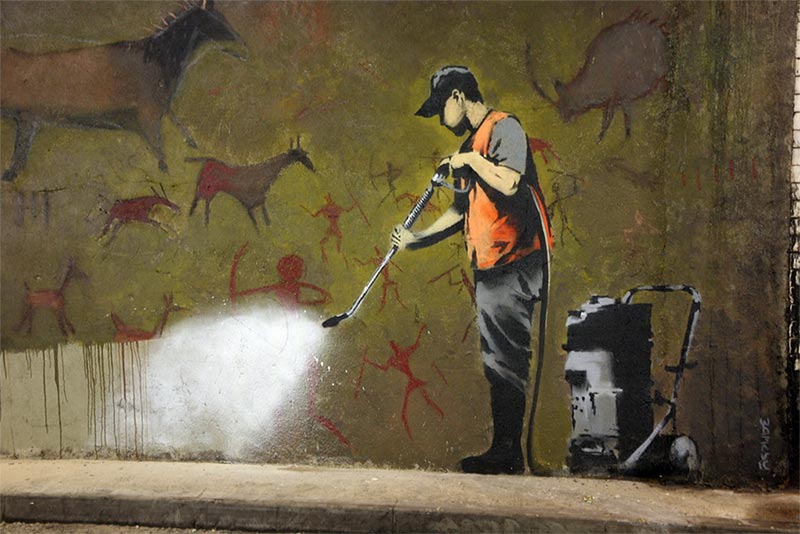The Guardian reports that a Banksy Paddington Bear mural worth £5,000 got grey-washed by overzealous Glastonbury council volunteers who were trying to rid the municipality of that dreaded blight—graffiti. This is a case of life imitating art—or maybe proof of Banksy’s prophetic powers, as illustrated by a piece featured on his web site. It’s a mural showing a council volunteer grey-washing priceless pre-historic cave paintings like those found at Lascaux.

This is a variation of the Prince and the Pauper story, a folk tale made famous by Mark Twain in his 1881 novel, and endlessly reworked by Hollywood stars as diverse as Errol Flynn and Eddie Murphy. It has a precursor in Matt 25:40: “just as you did it to one of the least of these who are members of my family, you did it to me.” Something of extraordinary value passes for commonplace, and those who recognize the extraordinary value are rewarded for their astuteness while those who mistreat it are punished.
The Washington Post published a similar account. On January 12, 2007, the Post arranged for Joshua Bell, one of the world’s pre-eminent violinists, to pose as a busker during the morning rush hour and spend 45 minutes playing some of the finest music ever written on one of the finest instruments ever crafted, a $US 3.5 million Stradivarius. As the article points out, Bell typically commands a fee that works out to $1,000 a minute. That morning, 1,097 commuters passed Bell as he played. He made a grand total of $32.17 from twenty-seven people. Only seven stopped to listen. All the passing children noticed Bell and tried to stop notwithstanding harried parents who pulled them along.
Like the Guardian story about the Banksy mural, the Washington Post article tries to explain the lack of interest as a deficiency in the listeners. “If only they knew.” They are culturally stunted. Or they are sleep walking through life. Or they are so swept up in the business of practical living that they haven’t time to slow down and enjoy unexpected gifts in their midst. The Post offers a further possibility, suggesting that context may have something to do with it. When you pay $200 for a ticket, dress in a tuxedo, and sit in a plush concert hall, then all your expectations are keyed to a cultural experience. Encountering a concert violinist in the middle of rush hour is too dissonant. In the same way, we can’t experience paint on a brick wall as art because our encounters with culture require a certain preparedness that an urban context undermines. We need a proper gallery before we can see the paint as art.
Or maybe these articles are unwitting illustrations of culture as a class construction. Note how each article presents to us the hidden value, the prince in the pauper’s clothes, or the god in the peasant’s rags. We know the Banksy mural is “real” culture because its owner had just negotiated its sale for £5,000. We know Bell’s playing is “real” music because he commands a fee of $1,000 a minute and plays on a Strad worth $US 3.5 million. Culture is validated by its viability as a commercial product capable of being consumed by a purchasing public. In the same way, we can’t read a book unless a critic’s stamp of approval appears on the dust jacket beside the $35 price tag. We don’t trust our own judgment. We aren’t willing to like a work simply because we like it. Instead, we turn taste into a social event by surrendering to the forces of the market.
But who’s to say the forces of the market are any less blind to cultural value than the Glastonbury council volunteer or the Washington civil servant rushing to her office?
Then again, you didn’t pay anything for my opinion, so it’s probably deficient in any event. So give me a $1,000 and I’ll tell you what to think. You’ll get value for your money. I guarantee it.